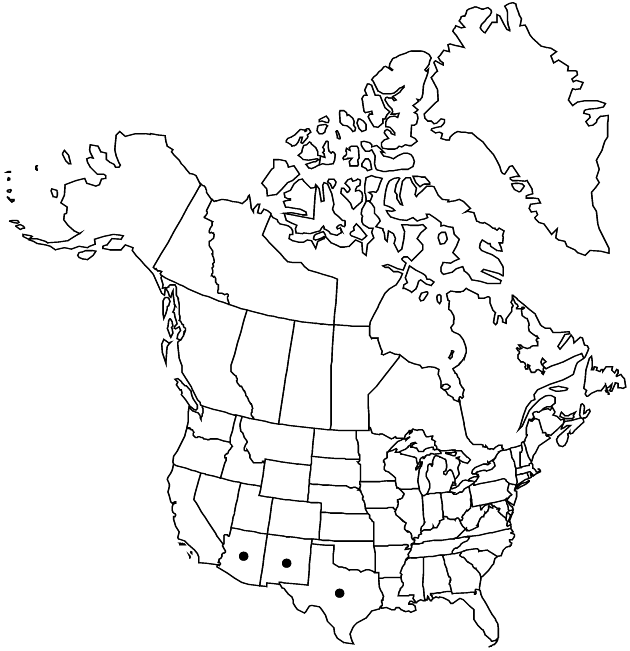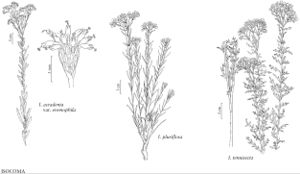Difference between revisions of "Isocoma pluriflora"
Erythea 2: 111. 1894.
FNA>Volume Importer |
FNA>Volume Importer |
||
| Line 15: | Line 15: | ||
|name=Haplopappus heterophyllus | |name=Haplopappus heterophyllus | ||
|authority=(A. Gray) S. F. Blake | |authority=(A. Gray) S. F. Blake | ||
| − | }}{{Treatment/ID/Synonym | + | }} {{Treatment/ID/Synonym |
|name=Haplopappus pluriflorus | |name=Haplopappus pluriflorus | ||
|authority=(Torrey & A. Gray) H. M. Hall | |authority=(Torrey & A. Gray) H. M. Hall | ||
| − | }}{{Treatment/ID/Synonym | + | }} {{Treatment/ID/Synonym |
|name=Isocoma wrightii | |name=Isocoma wrightii | ||
|authority=(A. Gray) Rydberg | |authority=(A. Gray) Rydberg | ||
| Line 36: | Line 36: | ||
|elevation=400–1400(–1600) m | |elevation=400–1400(–1600) m | ||
|distribution=Ariz.;N.Mex.;Tex.;Mexico (Chihuahua;Coahuila). | |distribution=Ariz.;N.Mex.;Tex.;Mexico (Chihuahua;Coahuila). | ||
| − | |discussion=<p>Like other species of Isocoma, I. pluriflora usually is gland-dotted, but scattered plants are stipitate-glandular.</p> | + | |discussion=<p>Like other species of <i>Isocoma</i>, <i>I. pluriflora</i> usually is gland-dotted, but scattered plants are stipitate-glandular.</p> |
|tables= | |tables= | ||
|references= | |references= | ||
| Line 60: | Line 60: | ||
|publication year=1894 | |publication year=1894 | ||
|special status= | |special status= | ||
| − | |source xml=https://jpend@bitbucket.org/aafc-mbb/fna-data-curation.git/src/ | + | |source xml=https://jpend@bitbucket.org/aafc-mbb/fna-data-curation.git/src/8f726806613d60c220dc4493de13607dd3150896/coarse_grained_fna_xml/V19-20-21/V20_1022.xml |
|tribe=Asteraceae tribe Astereae | |tribe=Asteraceae tribe Astereae | ||
|genus=Isocoma | |genus=Isocoma | ||
Revision as of 15:16, 18 September 2019
Herbage usually glabrous or sparsely hispidulous, sometimes densely hirtellous, leaves sometimes stipitate-glandular, never resinous. Leaf blades oblanceolate to narrowly oblong-oblanceolate or nearly linear, mostly 10–40(–50) mm, margins usually entire (hispidulous-cilate, sometimes also on faces), sometimes shallowly toothed distally (especially along western margin of range; teeth in 1(–3) pairs). Involucres 3.2–5.5 × 2.5–4 mm. Phyllary apices yellowish, or if green, then margins scarious, not aristate, gland-dotted, without resin pockets. Florets (8–)11–17(–21); corollas 5–6 mm. Cypsela ribs not forming hornlike extensions. 2n = 12, 24.
Phenology: Flowering (Apr–)Jul–Oct.
Habitat: Igneous or calcareous substrates, sometimes over gypsum, sandy or clay loam, commonly with Larrea-Prosopis
Elevation: 400–1400(–1600) m
Distribution

Ariz., N.Mex., Tex., Mexico (Chihuahua, Coahuila).
Discussion
Like other species of Isocoma, I. pluriflora usually is gland-dotted, but scattered plants are stipitate-glandular.
Selected References
None.
